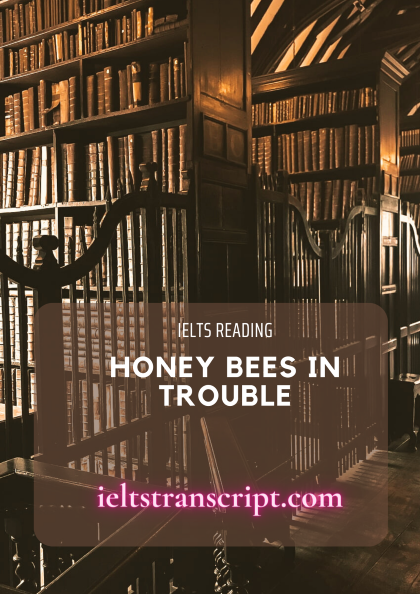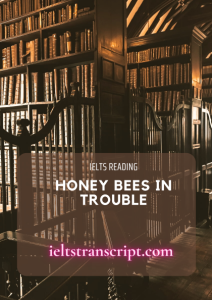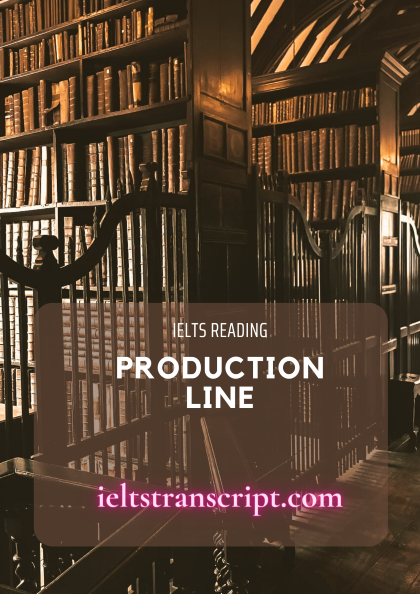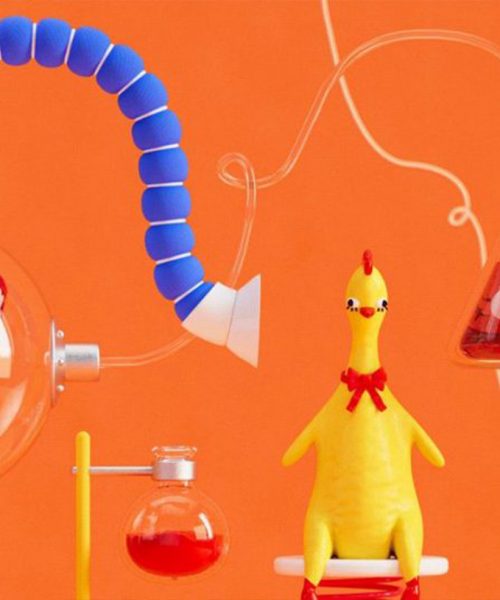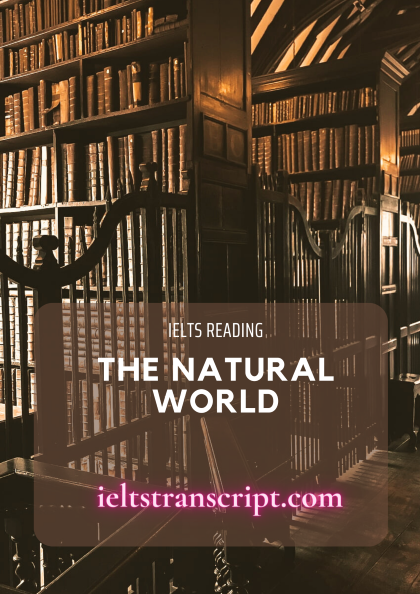- Đối với sản phẩm có giá: Sau khi chúng tôi ghi nhận thông tin đã thanh toán sản phẩm của bạn, sản phẩm sẽ được mở khóa và bạn có thể xem trực tiếp và tải tài liệu sản phẩm.
- Đối với thành viên trả phí: Bạn có thể mua và thanh toán sản phẩm với giá 0đ để tải tài liệu sản phẩm.
- Bạn có thể liên hệ với chúng tôi để được hỗ trợ mở khóa sản phẩm sớm nhất.
HONEY BEES IN TROUBLE
- Chúng tôi chấp nhận các phương thức thanh toán sau đây: Thẻ tín dụng, thẻ ghi nợ, PayPal, chuyển khoản ngân hàng và tiền mặt.
Chúng tôi sẽ không thu thêm phí cho bất kỳ hình thức thanh toán nào.
- Nếu bạn gặp vấn đề về sản phẩm của chúng tôi trong thời gian sử dụng, vui lòng liên hệ với chúng tôi để được hỗ trợ xử lý sớm nhất nhé.
Xem trước mẫu
Honey bees in trouble
Can native pollinators fill the gap?
A Recently, ominous headlines have described a mysterious ailment, colony collapse disorder(CCD),that is wiping out the honeybees that pollinate many crops. Without honeybees, the story goes, fields will be sterile, economies will collapse, and food will be scarce.
B But what few accounts acknowledge is that what’s at risk is not itself a natural state of affairs. For one thing, in the United States, where CCD was first reported and has had its greatest impacts, honeybees are not a native species. Pollination in modem agriculture isn’t alchemy, it’s industry. The total number of hives involved in the U.S. pollination industry has been somewhere between 2.5 million and 3 million in recent years. Meanwhile, American farmers began using large quantities of organophosphate insecticides, planted large-scale crop mono-cultures, and adopted “clean farming” practices that scrubbed native vegetation from field margins and roadsides. These practices killed many native bees outright—they’re as vulnerable to insecticides as any agricultural pest—and made the agricultural landscape inhospitable to those that remained. Concern about these practices and their effects on pollinators isn’t new—in her 1962 ecological alarm cry Silent Spring, Rachel Carson warned of a ‘Fruitless Fall’ that could result from the disappearance of insect pollinators.
C If that ‘Fruitless Fall, has not—yet—occurred, it may be largely thanks to the honeybee, which farmers turned to as the ability of wild pollinators to service crops declined. The honeybee has been semi-domesticated since the time of the ancient Egyptians, but it wasn’t just familiarity that determined this choice: the bees’ biology is in many ways suited to the kind of agricultural system that was emerging. For example, honeybee hives can be closed up and moved out of the way when pesticides are applied to a field. The bees are generalist pollinators, so they can be used to pollinate many different crops. And although they are not the most efficient pollinator of every crop, honeybees have strength in numbers, with 20,000 to 100,000 bees living in a single hive. “Without a doubt, if there was one bee you wanted for agriculture, it would be the honeybee, “says Jim Cane, of the U.S. Department of Agriculture. The honeybee, in other words, has become a crucial cog in the modem system of industrial agriculture. That system delivers more food, and more kinds of it, to more places, more cheaply than ever before. But that system is also vulnerable, because making a farm field into the photosynthetic equivalent of a factory floor, and pollination into a series of continent-long assembly lines, also leaches out some of the resilience characteristic of natural ecosystems.
D Breno Freitas, an agronomist, pointed out that in nature such a high degree of specialization usually is a very dangerous game: it works well while all the rest is in equilibrium, but runs quickly to extinction at the least disbalance. In effect, by developing an agricultural system that is heavily reliant on a single pollinator species, we humans have become riskily overspecialized. And when the human-honeybee relationship is disrupted, as it has been by colony collapse disorder, the vulnerability of that agricultural system begins to become clear.
E In fact, a few wild bees are already being successfully managed for crop pollination. “The problem is trying to provide native bees in adequate numbers on a reliable basis in a fairly short number of years in order to service the crop,” Jim Cane says. “You’re talking millions of flowers per acre in a two-to three-week time frame, or less, for a lot of crops.” On the other hand, native bees can be much more efficient pollinators of certain crops than honeybees, so you don’t need as many to do the job. For example, about 750 blue orchard bees (Osmia lignaria) can pollinate a hectare of apples or
...Ong mật lâm nguy
Các loài thụ phấn bản địa có thể đáp ứng những thiếu hụt?
A Gần đây, xuất hiện những tin tức đáng lo ngại mô tả một căn bệnh bí ẩn, rối loạn sụt giảm bầy đàn (CCD), đang xóa sổ những con ong mật thụ phấn cho nhiều loại cây trồng. Nếu không có ong mật, câu chuyện sẽ diễn ra theo chiều hướng các cánh đồng sẽ trở nên cằn cỗi, các nền kinh tế sẽ sụp đổ, và lương thực trở nên khan hiếm.
B Nhưng điều mà ít bài báo nào thừa nhận là bản thân sự rủi ro ấy không phải là trạng thái tự nhiên của vấn đề. Một ví dụ tại Mỹ, nơi CCD lần đầu tiên được ghi nhận và để lại những ảnh hưởng lớn nhất, ong mật không phải là loài bản địa. Sự thụ phấn trong nông nghiệp hiện đại không phải là thuật giả kim, mà là ngành công nghiệp. Tổng số lượng tổ ong tham gia vào ngành công nghiệp thụ phấn của Mỹ vào khoảng 2,5 đến 3 triệu trong những năm gần đây. Trong khi đó, nông dân Mỹ bắt đầu sử dụng một lượng lớn thuốc trừ sâu organophosphate, trồng các loại cây độc canh trên quy mô lớn và áp dụng các phương pháp “canh tác sạch” loại bỏ các loài thực vật bản địa từ các bờ ruộng và ven đường. Những phương thức này đã giết chết toàn bộ các loài ong bản địa – chúng dễ bị tổn hại bởi thuốc trừ sâu giống như bất kỳ các loài sâu bệnh nông nghiệp nào – và làm cho môi trường nông nghiệp không thể sinh sống được đối với những con ong còn sót lại. Mối quan tâm đối với những phương thức này và ảnh hưởng của chúng đối với các loài thụ phấn không phải là mới – Rachel Carson, trong cuốn sách về cảnh báo sinh thái Silent Spring của bà xuất bản năm 1962, đã khuyến cáo về một ‘Mùa thu không cây trái’ có thể là kết quả do sự biến mất của các loài côn trùng thụ phấn.
C Nếu “Mùa thu không cây trái đó chưa xảy ra”, thì có thể phần lớn là nhờ loài ong mật mà người nông dân chuyển sang sử dụng khi khả năng phục vụ cây trồng của các loài thụ phấn hoang dã bị suy giảm. Ong mật đã được bán thuần hóa từ thời Ai Cập cổ đại, nhưng không chỉ sự quen thuộc là yếu tố quyết định cho lựa chọn này: đặc tính sinh học của ong theo nhiều cách phù hợp với kiểu hệ thống nông nghiệp đang thịnh hành. Ví dụ, tổ ong mật có thể được đóng kín lại và di chuyển ra ngoài khi thuốc trừ sâu được sử dụng trên đồng. Ong là loài thụ phấn đa năng nhất, vì vậy chúng có thể được sử dụng để thụ phấn cho nhiều loại cây trồng khác nhau. Và mặc dù chúng không phải là loài thụ phấn hiệu quả nhất cho mọi loại cây trồng, nhưng ong mật có điểm mạnh về số lượng, với 20.000 đến 100.000 con ong sống trong một tổ duy nhất. Jim Cane, đến từ Bộ Nông nghiệp Hoa Kỳ nói: “Không còn nghi ngờ gì nữa, nếu có một loài ong mà bạn muốn sử dụng trong nông nghiệp, đó sẽ là ong mật.” Nói cách khác, ong mật đã trở thành một bánh răng thiết yếu trong hệ thống hiện đại của nền nông nghiệp đã được công nghiệp hóa. Hệ thống đó cung cấp nhiều thực phẩm hơn và nhiều chủng loại hơn đến nhiều nơi hơn, với giá rẻ hơn bao giờ hết. Nhưng hệ thống đó cũng dễ bị tổn thương, bởi vì việc biến một cánh đồng nông trại thành nơi quang hợp tương đương với sàn nhà máy, và việc thụ phấn thành một chuỗi dây chuyền lắp ráp dài khắp lục địa, cũng lấy mất đi một số đặc tính về khả năng hồi phục của các hệ sinh thái tự nhiên.
D Breno Freitas, một nhà nông học, đã chỉ ra rằng mức độ chuyên môn hóa cao như vậy trong tự nhiên thường là một trò chơi rất nguy hiểm: nó hoạt động tốt trong khi tất cả phần còn lại ở trạng thái cân bằng, nhưng sẽ nhanh chóng dẫn tới tuyệt chủng khi xảy ra chỉ một chút mất cân bằng. Trên thực tế, bằng cách phát triển một hệ thống nông nghiệp phụ thuộc nhiều vào một loài thụ phấn duy nhất, con người chúng ta đã trở nên chuyên môn hóa quá mức đầy rủi ro. Và khi mối quan hệ con người – ong mật bị gián đoạn, như nó đã từng xảy ra bởi rối loạn sụt giảm bầy đàn, tính dễ bị tổn thương của hệ thống nông nghiệp đó bắt đầu bị phơi bày rõ ràng.
E Thực tế là một vài loại ong rừng đã được chế ngự thành công để thụ phấn cho cây trồng. Jim Cane nói: “Vấn đề là phải cố gắng cung cấp đủ số lượng ong bản
...Để xem được đầy đủ nội dung và tải dữ liệu, bạn phải trở thành thành viên của chúng tôi và trả phí cho tài liệu (nếu có)
